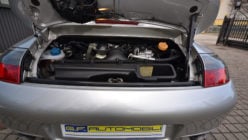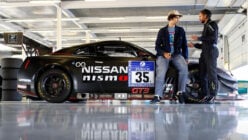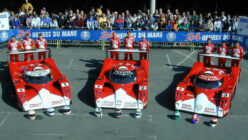After 17 years, the Porsche 911 GT3 is returning to the Gran Turismo series. To mark this occasion, we are dedicating this week’s “Wednesday Want” to the real thing.
The story of the GT3 starts in 1998 when Porsche launched the 996 model. This started a new era for the company, much to the dismay of some 911 enthusiasts. After 35 years of using an air-cooled engine in the 911, Porsche moved to water-cooled for its new car.
In sort of a one-two punch, the 996 also introduced a new body style for the 911. Prior models all looked relatively similar and shared similar design cues. With the 996 Porsche made the 911 more aerodynamic while still keeping the iconic shape.
As part of the new redesign, Porsche also introduced a new variant to its line: the GT3. However, if you lived in America you were out of luck.
Thankfully, today we get the GT3, along with its RS and R counterparts. But during the 996.1 generation, the GT3 eluded us — at least in road legal guise. Porsche would still sell you one if you kept it on the track.
Keeping it on the track probably wasn’t a bad thing. The GT3 was essentially a race car for the road and made less sense on the public highway.

To give it its race car feel, Porsche engineers worked their magic on the GT3.
To start with Porsche stripped any unnecessary weight. This included things like sound deadening, air conditioning, a radio, and bulky seats. Although if you were keen to have air con and some tunes, Porsche would add those back in for you. The weight savings totaled around 100lb with a curb weight of 2,977lb. On paper, this doesn’t seem like much for all that effort.
But while Porsche removed some features, it put in place others. The chassis had additional bracing throughout and you could even spec your GT3 with a half roll cage and six-point safety harness. That wasn’t all though; the brakes were bigger, the transmission beefier, and the suspension was stouter. All this added up to make for an excellent car both on and off the track.
To power the GT3, Porsche looked past the standard 911 and to its Le Mans program. It used an engine similar to that found in the 911 GT1 and 962 race cars, known as the Mezger engine. Porsche increased the displacement to 3.6 liters, and lost the twin turbos in favor of a naturally aspirated setup.

This put the power output at around 360hp, giving it 64 more ponies than the standard 911. It would hit 60 in 4.6 seconds and flat out would reach 188mph.
As you’d expect, a car of this caliber remains highly sought after today. They are somewhat rare with just 1,900 units built during the 996.1 generation. But still obtainable if you’re in the market for one.
There are a few currently for sale through various websites. However, the one that caught our attention is from G.F. Automobili located in Saonara, Italy.
It’s a 1999 model with a build date of July 1999. This makes it one of the first GT3s to roll out of the Weissach factory.
The exterior is Arctic Silver and the paint seems to be in outstanding condition. It also features a set of 18-inch modular wheels which also look great on the car.
In terms of options, it does come with niceties like a radio and air conditioning. This makes it slightly more livable on the road, which is apparently where this car spent all of its time.
According to the listing, this GT3 never went to the track, which is a bit of a shame. Although given the 38,000 miles on the clock, it didn’t spend a ton of time on the road either.
The list price for the GT3 €89,000 ($104,000) and is right around the ballpark for other cars up for sale.
Thankfully, to experience the 996 911 GT3 for yourself you won’t need to shell out that kind of money. All you need to do is boot up Gran Turismo Sport today and download the v1.28 update.
See more articles on Porsche, Porsche 911 GT3, and Wednesday Want.













